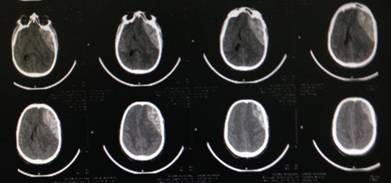Urgency for surgical evacuation of post traumatic Intracranial acute epidural hematoma
Abstract
Introduction: Intracranial epidural haematoma, (EDH) is a collection of blood between the skull and dura mater due to head injury. It is considered to be the most serious complication of head injury requiring immediate diagnosis and surgical intervention.
Background: The aim of our study was to present the outcome of consecutive patients with Acute EDH managed surgically & to prove the high risk of death or permanent brain damage without prompt surgical intervention.
Method: In this study we retrospectively examined all consecutive head injury cases managed between September 2014 & September 2015 and diagnosed with acute traumatic epidural hematoma in isolation or in combination with intra cranial lesions. Age, sex, mechanism of injury, time of presentation, Glasgow Coma Score (GCS), pupil reactivity, time of surgery and clinical outcomes were evaluated.
Results: Out of 31 cases 87%, (n=27) were males and 13 %,( n=4) were females. The mean age was 17.75 years. 74% (n=23) patients under the age of 25years. The most common mode of injury was road traffic accident 48%, (n=15) followed by fall 42%, (n=13). The mortality rate was 6% (n=2). The time interval between trauma & operation of both patients who died were more than 8 hours.
Conclusions: An acute epidural hematoma is an emergency condition, the diagnosis of the EDH must be promptly made by CT scan and the patient should be immediately transferred into a neurosurgical centre, Early surgical intervention is associated with the best outcome.
Downloads
References
2. Bullock MR, Chesnut R, Ghajar J, Gordon D, Hartl R, Newell DW et al.: Surgical Management of acute epidural haematomas. Neurosurgery 2006; vol. 58:(Supplement) 52-7. [PubMed]
3. Cheung PS, Lam JM, Yeung JH, Graham CA, Rainer TH. Outcome of traumatic extradural haematoma in Hong Kong. Injury. 2007;38(1):76-80. [PubMed]
4. Jacobson HA. On middle meningeal haemorrhage. Guys Hos Rep 1964; 43:143 – 308. 20. [PubMed]
5. Royal College of Surgeons of England Trauma Committee. The Royal College of Surgeons of England: A Position Paper on the Acute Management of Patients with Head Injury. Ann R Coll Surg Engl. 2005;87:323–5. [PubMed]
6. Chowdhury Noman Khaled et al.: Surgical management of traumatic extradural haematoma: Experiences with 610 patients and prospective analysis. Indian Journal of Neurotrauma (IJNT) 2008, Vol. 5, No. 2, pp. 75-79.
7. Pereira CU, Santos EAS, Cavalcante S, Serra MV, Pascotto D, Fontora EAF. Hematoma extradural intracraniano. J bras neurocir. 2005;16(1):25-34.
8. Ligia Tataranu, Vasile Ciubotaru, Dan Paunescu, Andrei Spatariu, Mugurel Rado. Extradural hematoma – is surgery always mandatory? Rom J Leg Med [22] 45-50 [2014]
DOI: 10.4323/rjlm.2014.45
9. Gerlach R, Dittrich S, Schneider W, Ackermann H, Seifert V, Kieslich M. Traumatic epidural hematomas in children and adolescents: Outcome analysis in 39 consecutive unselected cases. Pediatr Emerg Care. 2009;25:164–9. [PubMed]
10. Bricolo AP, Pasut LM. Extradural hematoma: Toward zero mortality. A prospective study. Neurosurgery. 1984;14:8–12. [PubMed]
11. Royal College of Surgeons of England Trauma Committee. The Royal College of Surgeons of England: A Position Paper on the Acute Management of Patients with Head Injury. Ann R Coll Surg Engl. 2005;87:323–5.



 OAI - Open Archives Initiative
OAI - Open Archives Initiative


